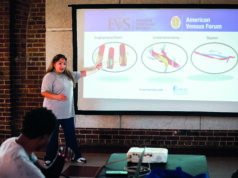
The workforce shortage issues set to plague vascular surgery over the next few decades, alongside an aging population and increase in vascular disease, formed the backdrop to a 2022 Vascular Annual Meeting (VAM) breakout session in Boston (June 15–18) designed to help surgeons navigate the tricky waters of starting a vascular training program.
Organizers and moderators Malachi Sheahan III, MD and Jeffrey Jim, MD, who together chaired the new program development section of the SVS Future of Vascular Surgery Task Force, sought to answer two top-line questions for those mulling over the possibility: “Do you have the resources? And where can you find help?” in an intimate, accessible setting at the Hynes Convention Center, the VAM 2022 host site.
The session ushered attendees through the process of establishing programs, including leadership and faculty requirements, the constitution of curricula, and other needs like a vascular lab.
Sheahan introduced a guidebook, entitled How to Develop A Vascular Surgery Training Program, a collaborative work from the Association of Program Directors in Vascular Surgery (APDVS) and the Society for Vascular Surgery (SVS).
The session was cast against the ever more pressing backdrop of predicted shortfalls in the number of practicing vascular surgeons.
“The U.S. population is increasing and aging,” he told those looking to help plug the workforce shortages expected to ensue through 2050. With cardiovascular disease continuing to be the country’s leading cause of death and morbidity, and the prevalence increasing 1–2% annually, the burden will remain, he outlined.
The workforce phenomenon is international, Sheahan added, sharing statistics laying out the scale of shortages in the United Kingdom, France and Canada. The session sought to explore the concept of increasing the supply of vascular surgeons, meaning more trainees, and explore the question of “can we preserve vascular surgery?”—which comes amid a burgeoning field of “vascular specialists” who are not vascular surgeons, Sheahan told Vascular Specialist@VAM.
Through the APDVS-SVS guidebook, a session aid, attendees heard about the complexities and intricacies of both the five-year integrated vascular residency and the vascular fellowship.
Earlier this year, Sheahan and Jim outlined the scale of the task at hand in a presentation at the annual meeting of the Society for Clinical Vascular Surgery (SCVS) annual meeting in Las Vegas. Helped by the task force’s efforts, Sheahan explained, 28 new vascular training programs had been established nationwide.
The collaboration formed between the SVS and APDVS helped clear up the prerequisites of the Residency Review Committee (RRC) of the Accreditation Council for Graduate Medical Education (ACGME) for the faculty and program director requirements needed to start both an integrated program and a fellowship.
The APDVS also provided stewardship to help guide those getting started through an often “byzantine and confusing” process, Sheahan said at SCVS 2022. They had also increased outreach efforts through such mediums as the VAM 2022 session in question, which is currently a recurring feature on the VAM schedule, he had added before the Las Vegas gathering. “With a bit of a push, there are a lot of people out there who want to train vascular surgeons,” Sheahan said.











